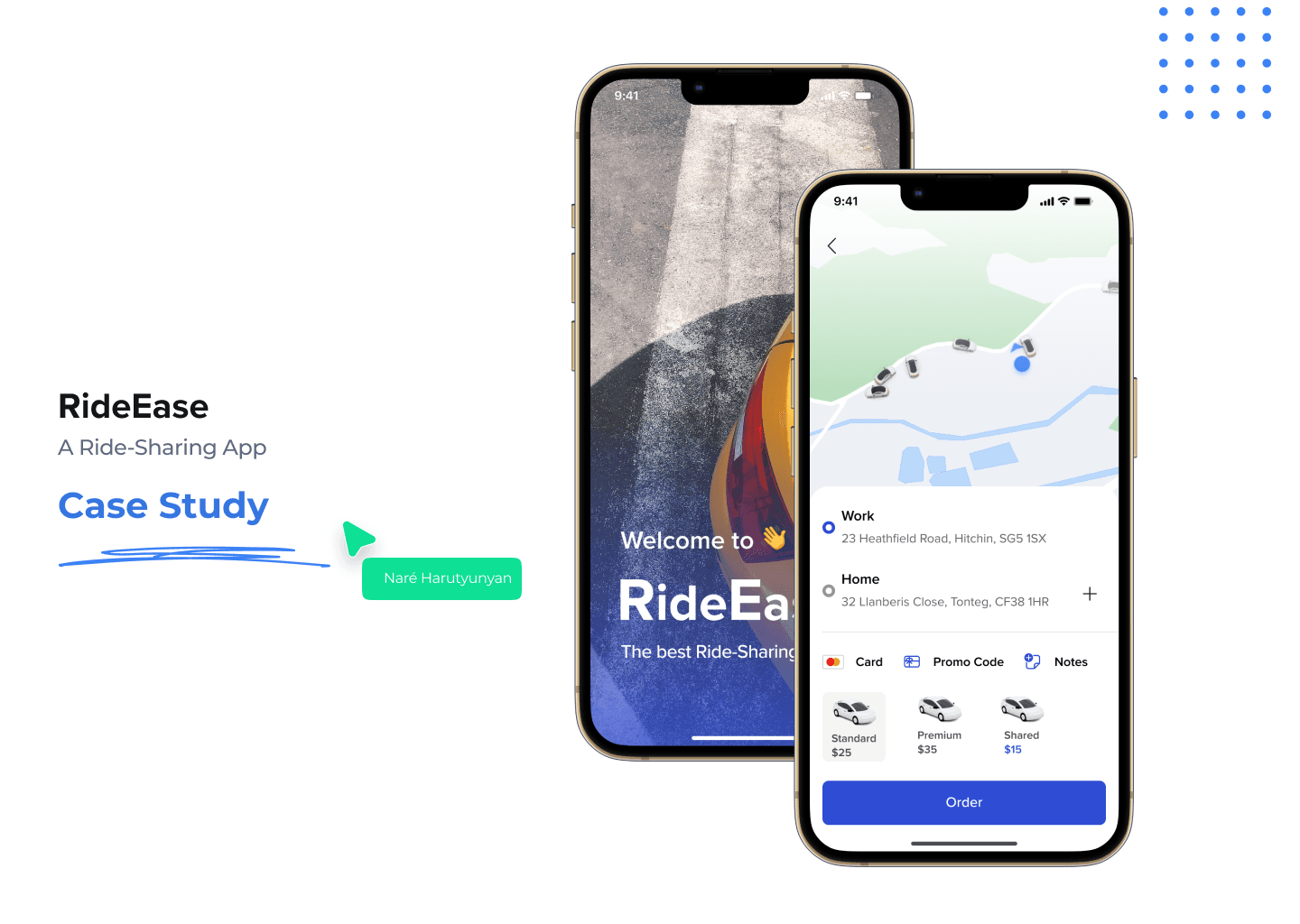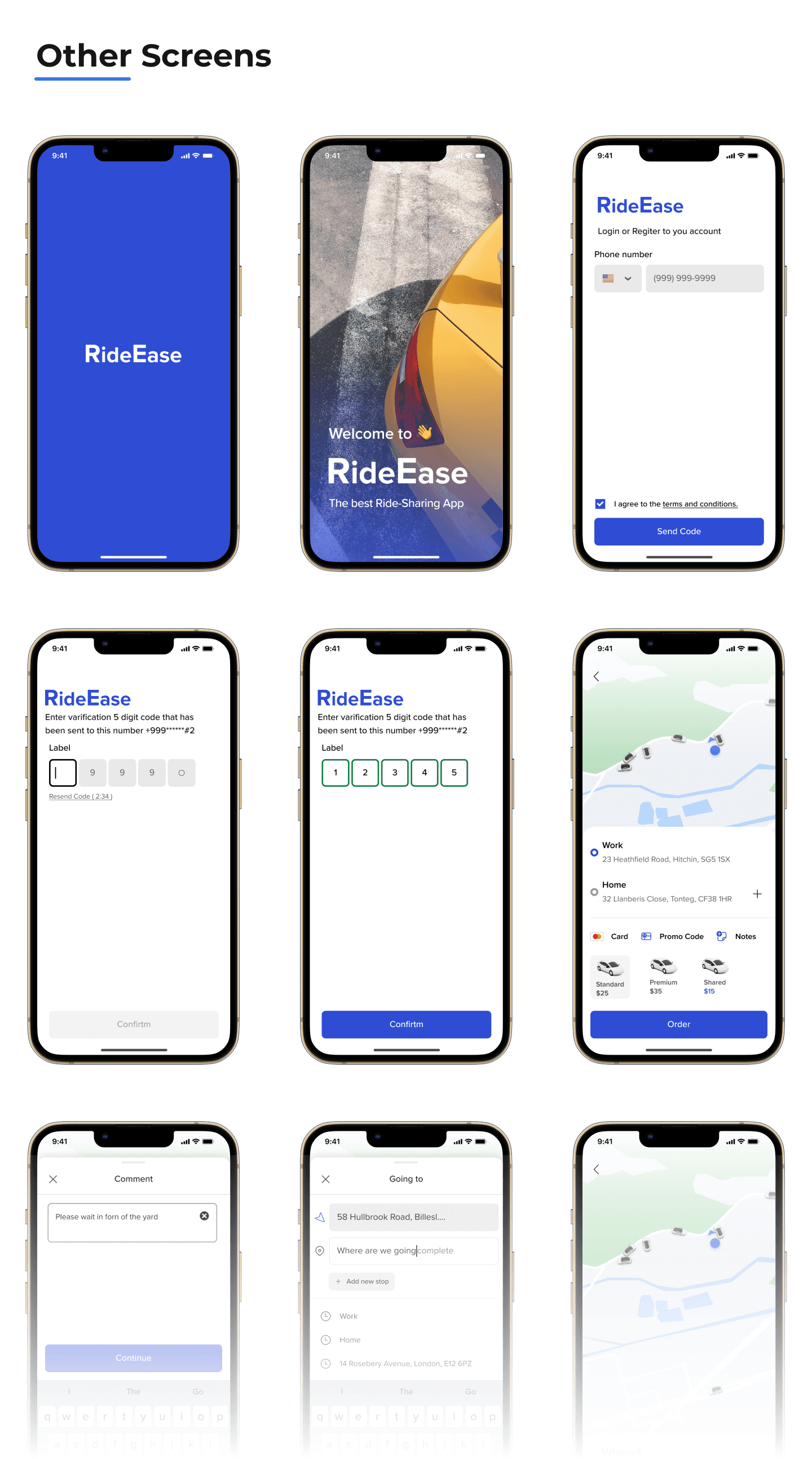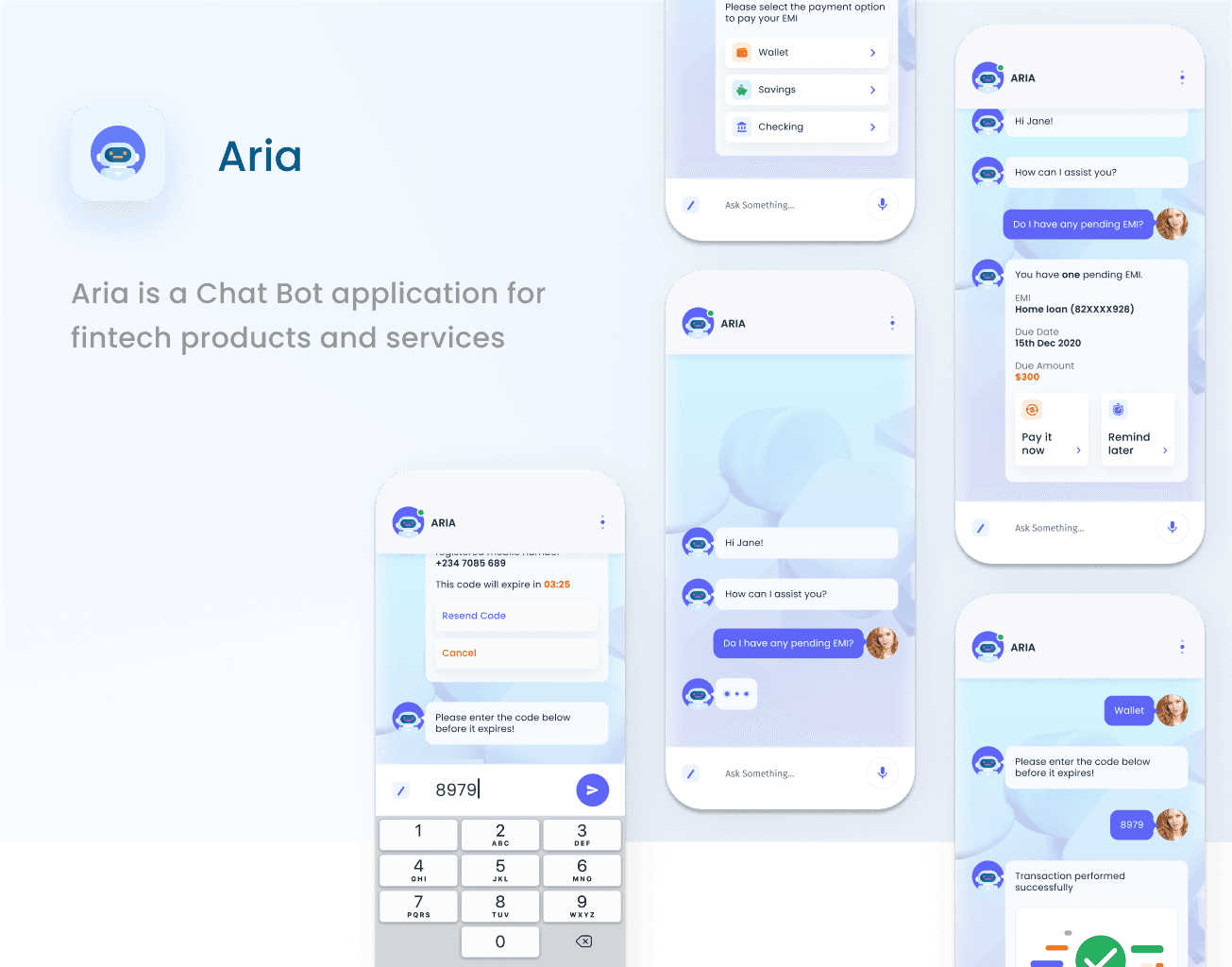Case Study
RideEase

Case Study
RideEase

RideEase is a mobile application that connects passengers with nearby drivers, providing quick and convenient transportation services. The app is designed to ensure a seamless user experience for both drivers and passengers, with features that prioritize safety, reliability, and affordability.
Product Objectives
The main objective of the project was to design and develop a ride-sharing app that would simplify the process of requesting and providing rides. The app needed to be easy to use, visually appealing, and functional across a variety of devices and operating systems. Key objectives included:
Target audience
Urban Dwellers: Individuals residing in densely populated areas where finding parking can be challenging and owning a car can be costly.
Commuters: Individuals who need to travel to and from work or school and are seeking an alternative to public transportation.
Young Adults: Individuals who may not have a car or prefer not to own one, and are seeking an affordable transportation option.
Travelers: People who are visiting a new city and need a reliable transportation option to get around
User Research
I conducted user research to understand pain points that riders and drivers face when using the app. I interviewed riders and drivers, and conducted surveys to gather feedback on the current app. We also analyzed user reviews of the app in the app store.
Competitive Analysis
This chart compares the features of the ride-sharing app with those of its competitors, including Uber, Lyft, and Grab. The features listed include in-app safety features, rewards programs, eco-friendly options, and seamless integration with public transportation. By examining the features offered by each competitor, the ride-sharing app can identify areas where it can differentiate itself and offer unique value to its users.
Quantitative Research
We conducted an online survey of 500 current ride-sharing users to collect quantitative data on their preferences and experiences with ride-sharing apps. The survey included questions on the following topics:
Screening criteria
- Use ride-sharing apps on a regular basis
- Are between the ages of 18 and 60
- Have access to a smartphone
- Live in an urban or suburban area with a high demand for ride-sharing services
- Have a valid driver's license and are comfortable using ride-sharing services as both a passenger and a driver (if the app includes a driver component)
Observations
75%
Frequency of use: We asked users how often they use ride-sharing apps, and found that 70% of respondents use a ride-sharing app at least once a week.
85%
Safety features: We asked users how important in-app safety features are to them when choosing a ride-sharing app, and found that 85% of respondents said that safety features are very important.
75%
Group ride options: We asked users if they would be interested in using a ride-sharing app that offers group ride options, and found that 75% of respondents said that they would be interested.
55% Uber, 35% Lyft
App preferences: We asked users which ride-sharing app they use most frequently, and found that 55% of respondents use Uber most often, while 35% use Lyft most often.
60%
Eco-friendly options: We asked users how likely they are to use a ride-sharing app that offers eco-friendly options, such as electric vehicles, and found that 60% of respondents said that they are very likely or somewhat likely to use such an app.
Surge pricing
Customers may be frustrated when the price of their ride suddenly increases during peak hours or high-demand times. They may feel like they are being taken advantage of, and this could cause them to switch to a different ride-sharing app or choose an alternative mode of transportation.
Safety concerns
Customers may feel anxious about their safety when using ride-sharing apps, especially at night or in unfamiliar areas. They may worry about getting into the wrong car or being taken advantage of by a driver. This could cause them to hesitate before using the app or switch to a competitor with a stronger safety record.
Lack of eco-friendly options
Customers who are environmentally conscious may be hesitant to use ride-sharing apps that rely on gasoline-powered vehicles. They may prefer to use electric or hybrid vehicles, but these options may not be available in all markets or may be priced higher than standard ride-sharing options.
Product Objectives
The main objective of the project was to design and develop a ride-sharing app that would simplify the process of requesting and providing rides. The app needed to be easy to use, visually appealing, and functional across a variety of devices and operating systems. Key objectives included:
Target audience
Urban Dwellers: Individuals residing in densely populated areas where finding parking can be challenging and owning a car can be costly.
Commuters: Individuals who need to travel to and from work or school and are seeking an alternative to public transportation.
Young Adults: Individuals who may not have a car or prefer not to own one, and are seeking an affordable transportation option.
Travelers: People who are visiting a new city and need a reliable transportation option to get around
User Research
I conducted user research to understand pain points that riders and drivers face when using the app. I interviewed riders and drivers, and conducted surveys to gather feedback on the current app. We also analyzed user reviews of the app in the app store.
Competitive Analysis
This chart compares the features of the ride-sharing app with those of its competitors, including Uber, Lyft, and Grab. The features listed include in-app safety features, rewards programs, eco-friendly options, and seamless integration with public transportation. By examining the features offered by each competitor, the ride-sharing app can identify areas where it can differentiate itself and offer unique value to its users.
Quantitative Research
We conducted an online survey of 500 current ride-sharing users to collect quantitative data on their preferences and experiences with ride-sharing apps. The survey included questions on the following topics:
Screening criteria
- Use ride-sharing apps on a regular basis
- Are between the ages of 18 and 60
- Have access to a smartphone
- Live in an urban or suburban area with a high demand for ride-sharing services
- Have a valid driver's license and are comfortable using ride-sharing services as both a passenger and a driver (if the app includes a driver component)
Observations
75%
Frequency of use: We asked users how often they use ride-sharing apps, and found that 70% of respondents use a ride-sharing app at least once a week.
85%
Safety features: We asked users how important in-app safety features are to them when choosing a ride-sharing app, and found that 85% of respondents said that safety features are very important.
75%
Group ride options: We asked users if they would be interested in using a ride-sharing app that offers group ride options, and found that 75% of respondents said that they would be interested.
55% Uber, 35% Lyft
App preferences: We asked users which ride-sharing app they use most frequently, and found that 55% of respondents use Uber most often, while 35% use Lyft most often.
60%
Eco-friendly options: We asked users how likely they are to use a ride-sharing app that offers eco-friendly options, such as electric vehicles, and found that 60% of respondents said that they are very likely or somewhat likely to use such an app.
Surge pricing
Customers may be frustrated when the price of their ride suddenly increases during peak hours or high-demand times. They may feel like they are being taken advantage of, and this could cause them to switch to a different ride-sharing app or choose an alternative mode of transportation.
Safety concerns
Customers may feel anxious about their safety when using ride-sharing apps, especially at night or in unfamiliar areas. They may worry about getting into the wrong car or being taken advantage of by a driver. This could cause them to hesitate before using the app or switch to a competitor with a stronger safety record.
Lack of eco-friendly options
Customers who are environmentally conscious may be hesitant to use ride-sharing apps that rely on gasoline-powered vehicles. They may prefer to use electric or hybrid vehicles, but these options may not be available in all markets or may be priced higher than standard ride-sharing options.
RideEase is a mobile application that connects passengers with nearby drivers, providing quick and convenient transportation services. The app is designed to ensure a seamless user experience for both drivers and passengers, with features that prioritize safety, reliability, and affordability.
Product Objectives
The main objective of the project was to design and develop a ride-sharing app that would simplify the process of requesting and providing rides. The app needed to be easy to use, visually appealing, and functional across a variety of devices and operating systems. Key objectives included:
Target audience
Urban Dwellers: Individuals residing in densely populated areas where finding parking can be challenging and owning a car can be costly.
Commuters: Individuals who need to travel to and from work or school and are seeking an alternative to public transportation.
Young Adults: Individuals who may not have a car or prefer not to own one, and are seeking an affordable transportation option.
Travelers: People who are visiting a new city and need a reliable transportation option to get around
User Research
I conducted user research to understand pain points that riders and drivers face when using the app. I interviewed riders and drivers, and conducted surveys to gather feedback on the current app. We also analyzed user reviews of the app in the app store.
Competitive Analysis
This chart compares the features of the ride-sharing app with those of its competitors, including Uber, Lyft, and Grab. The features listed include in-app safety features, rewards programs, eco-friendly options, and seamless integration with public transportation. By examining the features offered by each competitor, the ride-sharing app can identify areas where it can differentiate itself and offer unique value to its users.
Quantitative Research
We conducted an online survey of 500 current ride-sharing users to collect quantitative data on their preferences and experiences with ride-sharing apps. The survey included questions on the following topics:
Screening criteria
- Use ride-sharing apps on a regular basis
- Are between the ages of 18 and 60
- Have access to a smartphone
- Live in an urban or suburban area with a high demand for ride-sharing services
- Have a valid driver's license and are comfortable using ride-sharing services as both a passenger and a driver (if the app includes a driver component)
Observations
75%
Frequency of use: We asked users how often they use ride-sharing apps, and found that 70% of respondents use a ride-sharing app at least once a week.
85%
Safety features: We asked users how important in-app safety features are to them when choosing a ride-sharing app, and found that 85% of respondents said that safety features are very important.
75%
Group ride options: We asked users if they would be interested in using a ride-sharing app that offers group ride options, and found that 75% of respondents said that they would be interested.
55% Uber, 35% Lyft
App preferences: We asked users which ride-sharing app they use most frequently, and found that 55% of respondents use Uber most often, while 35% use Lyft most often.
60%
Eco-friendly options: We asked users how likely they are to use a ride-sharing app that offers eco-friendly options, such as electric vehicles, and found that 60% of respondents said that they are very likely or somewhat likely to use such an app.
Surge pricing
Customers may be frustrated when the price of their ride suddenly increases during peak hours or high-demand times. They may feel like they are being taken advantage of, and this could cause them to switch to a different ride-sharing app or choose an alternative mode of transportation.
Safety concerns
Customers may feel anxious about their safety when using ride-sharing apps, especially at night or in unfamiliar areas. They may worry about getting into the wrong car or being taken advantage of by a driver. This could cause them to hesitate before using the app or switch to a competitor with a stronger safety record.
Lack of eco-friendly options
Customers who are environmentally conscious may be hesitant to use ride-sharing apps that rely on gasoline-powered vehicles. They may prefer to use electric or hybrid vehicles, but these options may not be available in all markets or may be priced higher than standard ride-sharing options.








Other Case Studies
Check our other project case studies with detailed explanations
Other Case Studies
Check our other project case studies with detailed explanations
Other Case Studies
Check our other project case studies with detailed explanations


